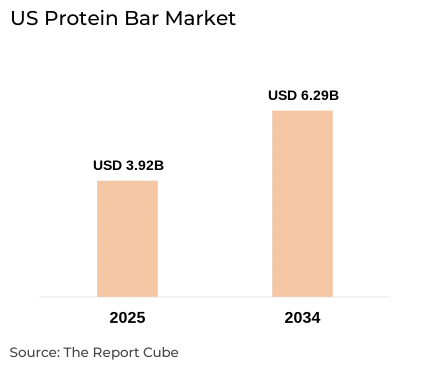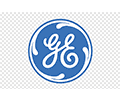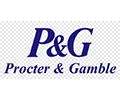
Understand The Key Trends Shaping This Market
Download Free SampleUS Protein Bar Market Overview: Market Size & Forecast (2026–2034)
What is the anticipated CAGR & size of the US Protein Bar Market?
The US Protein Bar Market is anticipated to register a CAGR of around 5.4% during the forecast period, 2026-34. Additionally, the market size was valued at nearly USD 3.92 billion in 2025 and is projected to reach nearly USD 6.29 billion by 2034.
Market Analysis & Insights
The US Protein Bar Market is generally a market that covers the wider categories like healthy snack / nutrition bar industry. It consists bars formulated to deliver high protein content (whey, casein, plant proteins like pea, rice, hemp, and soy) and frequently marketed for fitness, weight management, meal replacement, as well on-the-go nutrition. Further, customers progressively demand functional snacks (post-workout snacks & meal replacements) with clean labels, high protein, low sugar, and allergen-friendly formulations. Thus, this change underpins protein bars across USA expansion. Along with this, the protein bar segment’s growth is primarily robust in low-sugar, keto, plant-based, and clean-label variants.
Moreover, a numerous individuals seek convenient nutrition during work, travel, or workouts, protein bars fill the gap of portable, ready-to-eat snacks. Therefore, this elevates demand for bars with balanced nutrition, macro ratios, and diversified flavors (fruit and nut protein bar flavor, nut & seed inclusions). Along with this, to stand out in a competitive market, market companies are investing in novel proteins (pea, hemp, rice, insect, collagen), enhanced texture technologies, and improving digestibility. Hence, the market trends toward gluten-free & allergen-free options, clean-label, and “better-for-you” ingredients upscale the bar for differentiation across the US Protein Bar Market, further creating a positive market outlook.
The Protein Bar Market in the US is progressively accessible through supermarkets, convenience stores, gyms, pharmacies, and specifically e-commerce / online retail. Here online channels permit subscription models, new flavor launches, targeted promotions, and direct customer or buyer feedback loops. Further, looking ahead, the US Protein Bar Market Report emphasize upon the future prospects of the market. This is in line with the further personalization (DNA-based, lifestyle-based), AI-driven product development, expanded plant-based & functional ingredients, and deeper penetration through subscription & D2C (direct to consumer) models.
What is the Impact of AI in the US Protein Bar Market?
AI is altering the US Protein Bar Market via predictive analytics, personalized marketing, and optimized formulations, which assists in enabling brands to forecast demand, refine flavors, and tailor nutrition. Further, this incorporation is contributing in improving efficiency, decreasing expenses, and solidifying customer engagement & innovation across the US Protein Bar Market.
US Protein Bar Market Dynamics
What driving factor acts as a positive influencer for the US Protein Bar Market?
- Clean-Label & Functional Ingredient Demand: Customers are progressively demanding transparency, non-GMO, minimal artificial additives, allergen-free, plant-based proteins, which is acting as an influential driver for the US Protein Bar Market. Also, protein bars marketed as “high protein, low sugar, gluten-free” as well as clean-label is elevating market demand graph. Thus, this dynamic is more noticeable in the US than in many other regional market, driving innovation & shares.
What are the challenges that affect the US Protein Bar Market?
- Ingredient Cost Instability & Margin Pressure: Protein sources (whey, pea, hemp) face inconsistent raw-material costs, which is hampering the US Protein Bar Market growth. Furthermore, shipping, supply chain disruptions, and sourcing from sustainable/organic inputs surges costs. Also, brands require to maintain profits while balancing formulation costs & the price sensitivity of the US Protein Bar Market.

How are the future opportunities transforming the market during 2026-34?
- Personalization & Subscription/D2C Models: Through subscription platforms, there is an opportunity to provide customized bar compositions (like macros & preferred flavors). Further, this could enhance lifetime value, improve customer engagement, and enable niche businesses to prosper alongside well-known brands.
What market trends are affecting the US Protein Bar Market Outlook?
- Surge of Plant-based / Vegan / Alternative Proteins: The swing toward plant-based protein bars is augmenting, specifically among flexitarians & health-conscious individuals. Moreover, usage of pea, rice, hemp, and soy proteins is also growing creating trending market demand. Thus, this trend aligns with the wider plant-based movement & signals that protein bar industry is increasingly embracing non-animal sources.
How is the US Protein Bar Market Defined as per Segments?
The US Protein Bar Market Research Reports provide detailed market data & insights in accordance with market segmentation. Some of the segments are:
- Category: Conventional Protein Bars, Vegan/Plant-based Protein Bars, Low-Sugar / Keto Bars, Organic / Clean Label Bars
- Distribution Channel: Offline, Supermarkets & Hypermarkets Convenience Stores, Specialty Health & Nutrition Stores, Gyms, Fitness Clubs & Pharmacies, Online Retail / E-Commerce
By Category:
The Conventional Protein Bars (often called whey or mixed proteins) is observed to lead the US Protein Bar Market, accounting of the majority of market volume & revenue share. Scale, formulation maturity, and established consumer trust are the aspects making this category one of the dominant market segment. Also, plant-based & vegan protein bars are observed to expand owing to ethical & health-conscious tendencies, which would eventually improve the market share in the forecast years.
By Distribution Channel:
Among channels, Supermarkets & Hypermarkets / Offline Retail leads the US Protein Bar Market by attaining largest market share. This is attributed to the wider reach, customer accessibility, and impulse procurement patterns. Moreover, Online Retail / E-commerce is also witnessed to be one of the fastest-growing channel, enabling direct-to-consumer relationships, subscription models, and niche product visibility.
US Protein Bar Market: What Recent Innovations Are Affecting the Industry?
- 2025: Hershey’s protein snack brand, Fulfil, introduced a new Fulfil Reese’s Chocolate Peanut Butter Bar, combining Reese’s peanut butter with a protein bar format, and delivering 15–20 grams of protein per serving. This is distributed across leading retailers (Target, Walmart, Amazon).
What are the Key Highlights of the US Protein Bar Market (2026–34)?
- The US Protein Bar Market size is valued about USD 3.92 billion in 2025 and reaching to nearly USD 6.29 billion by 2034, further registering around 5.4% CAGR.
- Conventional protein bars dominate in volume, while vegan/plant-based & low-sugar/keto bars show the fastest expansion.
- Supermarkets leads the market sales, but online retail is anticipated to grow quickly.
- AI incorporation improves product innovation, demand forecasting, and personalized nutrition strategies across the Protein Bar Market in the US.
How does the Future Outlook of the US Protein Bar Market (2034) Appears?
At estimated market size of about USD 6.29 billion in 2034, the US Protein Bar Market is predicted to witness steady growth. Also, artificial intelligence (AI)-driven personalization & predictive nutrition would redefine product releases, pricing, and customer loyalty in this largely fragmented market, where the biggest protein bar companies would coexist with niche micro-brands. Moreover, protein bars would become a common post-workout snack & daily nutrition bar across the United States owing to customer demand for individualized, health-conscious products in the forecast years.
What Does Our US Protein Bar Market Research Study Entail?
- The US Protein Bar Market Research Report highlights the forecast growth rate (CAGR) by anticipating the market size and share.
- The market analysis & market scope sheds light upon the primary industry trends, driving aspects, potential opportunities, growth challenges, and other major factors.
- The US Protein Bar Market Research Report entails details about the most critical shifts in market share in the prominent regions.
- Considering the statistics & the developments by the primary market competitors, our report also strives to demonstrate the most sought-after strategies of the key players.
Table of Contents
1. Introduction
1.1 Objective of the Study
1.2 Product Definition
1.3 Market Segmentation
1.4 Study Variables
2. Research Methodology
2.1 Secondary Data Points
2.1.1 Companies Interviewed
2.2 Primary Data Points
2.2.1 Breakdown of Primary Interviews
3. Executive Summary
4. Market Dynamics
4.1 Drivers
4.2 Challenges
4.3 Opportunity Assessment
5. Recent Trends and Developments
6. Policy and Regulatory Landscape
7. US Protein Bar Market Overview (2020–2034)
7.1 Market Size, By Value (in USD Billion)
7.2 Market Share, By Category
7.2.1 Conventional Protein Bars
7.2.2 Vegan/Plant-based Protein Bars
7.2.3 Low-Sugar / Keto Bars
7.2.4 Organic / Clean Label Bars
7.3 Market Share, By Distribution Channel
7.3.1 Offline
7.3.1.1 Supermarkets & Hypermarkets
7.3.1.2 Convenience Stores
7.3.1.3 Specialty Health & Nutrition Stores
7.3.1.4 Gyms, Fitness Clubs & Pharmacies
7.3.2 Online Retail / E-Commerce
7.4 Market Share, By Protein Source
7.4.1 Animal Protein
7.4.2 Plant Protein
7.5 Market Share, By Flavour
7.5.1 Cranberry
7.5.2 Fruit & Nut Bar
7.5.3 Others
7.5.4 Choco Almond
7.5.5 Chocolate
7.6 Market Share, By Company
7.6.1 Revenue Shares
7.6.2 Competition Characteristics
8. US Protein Bar Market Overview, By Category, 2026–2034F
8.1 Conventional Protein Bars Market Overview, 2026–2034F
8.1.1 By Value (in USD Billion)
8.1.2 By Distribution Channel
8.1.3 By Protein Source
8.1.4 By Flavour
8.2 Vegan/Plant-based Protein Bars Market Overview, 2026–2034F
8.2.1 By Value (in USD Billion)
8.2.2 By Distribution Channel
8.2.3 By Protein Source
8.2.4 By Flavour
8.3 Low-Sugar / Keto Bars Market Overview, 2026–2034F
8.3.1 By Value (in USD Billion)
8.3.2 By Distribution Channel
8.3.3 By Protein Source
8.3.4 By Flavour
8.4 Organic / Clean Label Bars Market Overview, 2026–2034F
8.4.1 By Value (in USD Billion)
8.4.2 By Distribution Channel
8.4.3 By Protein Source
8.4.4 By Flavour
9. US Protein Bar Market Overview, By Distribution Channel, 2026–2034F
9.1 Offline Distribution Channel Market Overview, 2026–2034F
9.1.1 By Value (in USD Billion)
9.1.2 By Category
9.1.3 By Protein Source
9.1.4 By Flavour
9.2 Online Retail / E-Commerce Market Overview, 2026–2034F
9.2.1 By Value (in USD Billion)
9.2.2 By Category
9.2.3 By Protein Source
9.2.4 By Flavour
10. US Protein Bar Market Overview, By Protein Source, 2026–2034F
10.1 Animal Protein Market Overview, 2026–2034F
10.1.1 By Value (in USD Billion)
10.1.2 By Category
10.1.3 By Distribution Channel
10.1.4 By Flavour
10.2 Plant Protein Market Overview, 2026–2034F
10.2.1 By Value (in USD Billion)
10.2.2 By Category
10.2.3 By Distribution Channel
10.2.4 By Flavour
11. US Protein Bar Market Overview, By Flavour, 2026–2034F
11.1 Cranberry Market Overview, 2026–2034F
11.1.1 By Value (in USD Billion)
11.1.2 By Category
11.1.3 By Distribution Channel
11.1.4 By Protein Source
11.2 Fruit & Nut Bar Market Overview, 2026–2034F
11.2.1 By Value (in USD Billion)
11.2.2 By Category
11.2.3 By Distribution Channel
11.2.4 By Protein Source
11.3 Others Market Overview, 2026–2034F
11.3.1 By Value (in USD Billion)
11.3.2 By Category
11.3.3 By Distribution Channel
11.3.4 By Protein Source
11.4 Choco Almond Market Overview, 2026–2034F
11.4.1 By Value (in USD Billion)
11.4.2 By Category
11.4.3 By Distribution Channel
11.4.4 By Protein Source
11.5 Chocolate Market Overview, 2026–2034F
11.5.1 By Value (in USD Billion)
11.5.2 By Category
11.5.3 By Distribution Channel
11.5.4 By Protein Source
12. Competitive Outlook (Company Profiles)
12.1 Clif Bar & Company (Clif, Builders, Luna)
12.1.1 Company Overview
12.1.2 Business Segments
12.1.3 Strategic Alliances/Partnerships
12.1.4 Recent Developments
12.2 Kellogg's (RXBAR)
12.2.1 Company Overview
12.2.2 Business Segments
12.2.3 Strategic Alliances/Partnerships
12.2.4 Recent Developments
12.3 General Mills (Larabar)
12.3.1 Company Overview
12.3.2 Business Segments
12.3.3 Strategic Alliances/Partnerships
12.3.4 Recent Developments
12.4 Mars Incorporated (Kind)
12.4.1 Company Overview
12.4.2 Business Segments
12.4.3 Strategic Alliances/Partnerships
12.4.4 Recent Developments
12.5 The Hershey Company (ONE Brands)
12.5.1 Company Overview
12.5.2 Business Segments
12.5.3 Strategic Alliances/Partnerships
12.5.4 Recent Developments
12.6 Quest Nutrition
12.6.1 Company Overview
12.6.2 Business Segments
12.6.3 Strategic Alliances/Partnerships
12.6.4 Recent Developments
12.7 Think! (formerly ThinkThin)
12.7.1 Company Overview
12.7.2 Business Segments
12.7.3 Strategic Alliances/Partnerships
12.7.4 Recent Developments
12.8 Premier Protein
12.8.1 Company Overview
12.8.2 Business Segments
12.8.3 Strategic Alliances/Partnerships
12.8.4 Recent Developments
12.9 Simply Protein
12.9.1 Company Overview
12.9.2 Business Segments
12.9.3 Strategic Alliances/Partnerships
12.9.4 Recent Developments
13. Contact Us & Disclaimer
List of Figure
Figure 1.1 – Market Research Objective Overview
Figure 1.2 – Product Definition and Scope
Figure 1.3 – US Protein Bar Market Segmentation
Figure 1.4 – Study Variables Framework
Figure 2.1 – Research Methodology Flowchart
Figure 2.2 – Companies Interviewed (Secondary Data)
Figure 2.3 – Breakdown of Primary Interviews
Figure 3.1 – Executive Summary: Key Market Highlights
Figure 4.1 – Key Drivers of US Protein Bar Market
Figure 4.2 – Market Challenges
Figure 4.3 – Opportunity Assessment
Figure 5.1 – Recent Trends and Developments in US Protein Bar Market
Figure 6.1 – Policy & Regulatory Landscape Overview
Figure 7.1 – US Protein Bar Market Size (2020–2034, USD Billion)
Figure 7.2 – Market Share by Category (Conventional, Vegan, Low-Sugar/Keto, Organic)
Figure 7.3 – Market Share by Distribution Channel (Offline vs Online)
Figure 7.4 – Offline Distribution Channel Breakdown
Figure 7.5 – Online Retail / E-Commerce Market Share
Figure 7.6 – Market Share by Protein Source (Animal vs Plant)
Figure 7.7 – Market Share by Flavour (Cranberry, Fruit & Nut, Chocolate, Choco Almond, Others)
Figure 7.8 – Market Share by Company – Revenue and Competition
Figure 8.1 – Conventional Protein Bars Market Overview, 2026–2034
Figure 8.2 – Vegan/Plant-based Protein Bars Market Overview, 2026–2034
Figure 8.3 – Low-Sugar / Keto Bars Market Overview, 2026–2034
Figure 8.4 – Organic / Clean Label Bars Market Overview, 2026–2034
Figure 9.1 – Offline Distribution Channel Market Overview, 2026–2034
Figure 9.2 – Online Retail / E-Commerce Market Overview, 2026–2034
Figure 10.1 – Animal Protein Market Overview, 2026–2034
Figure 10.2 – Plant Protein Market Overview, 2026–2034
Figure 11.1 – Cranberry Market Overview, 2026–2034
Figure 11.2 – Fruit & Nut Bar Market Overview, 2026–2034
Figure 11.3 – Others Market Overview, 2026–2034
Figure 11.4 – Choco Almond Market Overview, 2026–2034
Figure 11.5 – Chocolate Market Overview, 2026–2034
Figure 12.1 – Competitive Landscape – Clif Bar & Company
Figure 12.2 – Competitive Landscape – Kellogg’s (RXBAR)
Figure 12.3 – Competitive Landscape – General Mills (Larabar)
Figure 12.4 – Competitive Landscape – Mars Incorporated (Kind)
Figure 12.5 – Competitive Landscape – The Hershey Company (ONE Brands)
Figure 12.6 – Competitive Landscape – Quest Nutrition
Figure 12.7 – Competitive Landscape – Think! (formerly ThinkThin)
Figure 12.8 – Competitive Landscape – Premier Protein
Figure 12.9 – Competitive Landscape – Simply Protein
Figure 13.1 – Contact & Disclaimer Information
List of Table
Table 1.1 – Study Objectives and Scope
Table 1.2 – Product Definition and Classification
Table 1.3 – Market Segmentation Variables
Table 2.1 – Secondary Data Sources
Table 2.2 – Companies Interviewed (Secondary Data)
Table 2.3 – Primary Interview Breakdown
Table 4.1 – Key Market Drivers
Table 4.2 – Market Challenges
Table 4.3 – Opportunity Assessment
Table 5.1 – Recent Trends and Developments
Table 6.1 – Policy & Regulatory Overview
Table 7.1 – US Protein Bar Market Size, 2020–2034 (USD Billion)
Table 7.2 – Market Share by Category
Table 7.3 – Market Share by Distribution Channel
Table 7.4 – Offline Distribution Channel Breakdown
Table 7.5 – Online Retail / E-Commerce Market Share
Table 7.6 – Market Share by Protein Source
Table 7.7 – Market Share by Flavour
Table 7.8 – Market Share by Company – Revenue & Competition
Table 8.1 – Conventional Protein Bars Market Forecast, 2026–2034
Table 8.2 – Vegan/Plant-based Protein Bars Market Forecast, 2026–2034
Table 8.3 – Low-Sugar / Keto Bars Market Forecast, 2026–2034
Table 8.4 – Organic / Clean Label Bars Market Forecast, 2026–2034
Table 9.1 – Offline Distribution Channel Market Forecast, 2026–2034
Table 9.2 – Online Retail / E-Commerce Market Forecast, 2026–2034
Table 10.1 – Animal Protein Market Forecast, 2026–2034
Table 10.2 – Plant Protein Market Forecast, 2026–2034
Table 11.1 – Cranberry Flavour Market Forecast, 2026–2034
Table 11.2 – Fruit & Nut Bar Market Forecast, 2026–2034
Table 11.3 – Others Flavour Market Forecast, 2026–2034
Table 11.4 – Choco Almond Market Forecast, 2026–2034
Table 11.5 – Chocolate Flavour Market Forecast, 2026–2034
Table 12.1 – Clif Bar & Company – Key Financials and Segments
Table 12.2 – Kellogg’s (RXBAR) – Key Financials and Segments
Table 12.3 – General Mills (Larabar) – Key Financials and Segments
Table 12.4 – Mars Incorporated (Kind) – Key Financials and Segments
Table 12.5 – The Hershey Company (ONE Brands) – Key Financials and Segments
Table 12.6 – Quest Nutrition – Key Financials and Segments
Table 12.7 – Think! (formerly ThinkThin) – Key Financials and Segments
Table 12.8 – Premier Protein – Key Financials and Segments
Table 12.9 – Simply Protein – Key Financials and Segments
Top Key Players & Market Share Outlook
- Clif Bar & Company (Clif, Builders, Luna)
- Kellogg's (RXBAR)
- General Mills (Larabar)
- Mars
- Incorporated (Kind)
- The Hershey Company (ONE Brands)
- Quest Nutrition
- Think! (formerly ThinkThin)
- Premier Protein
- Simply Protein
- Others
Frequently Asked Questions








